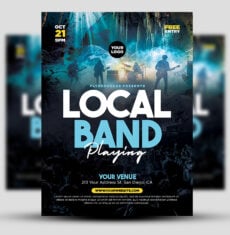Design is a tricky business. Designers often look to each other for inspiration and frequently base their projects on whatever’s in vogue because their clients demand the latest trends. As a result, similar designs abound—in magazines, on book covers and on the internet. There comes a point, though, when mild imitation turns to something a little more sinister: design plagiarism. Debate continues about where that line is, or whether it can even be properly defined, but if another designer copies your work verbatim without asking you first, you might have a problem on your hands. The question is, what can you do about it?
How People Take Credit
People take credit for each other’s work in various ways, some subtle and insidious and others more overt and brazen. At the very least, it can be annoying, and at most, it can lead to a serious loss of revenue.
Abject plagiarism: If another designer flat-out claims that they created your project and passes it off as unique, that is plagiarism at its most serious. You might find your project in their online portfolio or, even worse, live on a client site or in a printed publication. If you take your own photographs and they use your images without permission, that’s copyright fraud as well.
Very close imitation: You know that design lives in your virtual briefcase, but there are subtle differences between the work you created three years ago and the project you’re looking at now. Perhaps the designer swapped out fonts, used marginally different colors or put a distinctive design element somewhere else in their layout. In any case, your idea probably prompted their design. The right thing to do would have been for them to contact you and give you a little credit, but they didn’t. This type of thing falls into the “annoying” category, and there’s not always a lot you can do about it.
Design inspiration: If you happen to come up with a particularly excellent design, don’t be surprised if others imitate it—particularly if they’re a newly minted member of the creative industry. Young designers are always on the lookout for inspiration, so if you see something a little familiar in a portfolio, you might think of their mimicry as a form of flattery. After all, that kind of admiration makes you the guru, and you could benefit from the reputation boost.
Preventative Measures
There are numerous ways to try to stop imitation and blatant plagiarism before they start. You might decide to publish a brief anti-plagiarism statement at the bottom of each page on your website or in your portfolio. You could encourage designers to contact you if they want to use your designs for publication, too. A short sentence about copyright can also work wonders.
You already own the copyright to every photograph you’ve ever taken and used in your designs. You can also officially register each of your photographs with the United States Copyright Office, but the process is fairly expensive and can take over a year to complete. If you ever need to bring a lawsuit, however, having that formal registration in place means you can claim statutory damages of up to $150,000 per infringement. With that in mind, if you think you’ve captured something truly iconic, you might want to get that rubber stamp.
Now onto the important part: how to remedy flagrant imitation.
How to Make it Right
Before blowing off steam via email or exploding all over the blogosphere, ask a couple of other people to give you their take on your situation. If you’re in any doubt about what you see, discuss it with a few well-versed colleagues and get some peer feedback. Florida-based designer Paul Wallen, who saw his designs repeatedly imitated by others in the newspaper business, held an interesting online forum about design plagiarism with roughly 50 designers, all of whom had valuable input on the subject. Essentially, there are several ways to recover from artistic mimicry.
Be flattered:You could choose to take the imitation as a complement and leave it at that. Naturally this is sometimes easier said than done, particularly when a designer takes one of your concepts and actually improves upon it, leaving you to wonder, “Why didn’t I think of that?” Still, if it’s a minor design infraction, you might decide to give yourself a slap on the back and move on. There’s nothing wrong with that approach.
Start an expert design blog: If your designs are that good, why not capitalize upon your success? When people start to treat you like a guiding light, your response could be reciprocative. You could market yourself as an authority on design, writing articles about complicated Adobe-centric tricks and scholarly blog posts about the Golden Mean. That initial act of plagiarism could be a doorway into the next stage of your success.
Send a cease-and-desist letter: If you suddenly begin to see your designs on someone else’s site and they haven’t asked for permission to use your work, your action plan needs to begin with a cease-and-desist letter. You could send them a serious-sounding note via email or, if the situation calls for it, a formal letter on watermarked paper, delivered via registered mail. If your petition needs a little extra clout, you might decide to hire a lawyer to do the job for you.
Sue the other party: A lawsuit is no laughing matter. It’s a serious business, and requires considerable thought—and sometimes, considerable capital. If somebody else steals one of your designs and uses the design to make large amounts of cash, you can sue that individual for damages in court. This particularly applies when the other party repeatedly ignores cease-and-desist letters. To determine if you have the ingredients for a legal case, build up a good profile of the respondent and consult several reputable lawyers.
Every imitation situation is different. If your lightbulb moment leads to a groundbreaking Photoshop action and the design industry runs with it, for example, be prepared for mimicry aplenty. On the other hand, if someone uses your design without permission and refuses to stop taking credit for it, you might decide to take more definitive action to nip their design plagiarism in the bud. In the end, it’s up to you.













